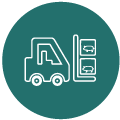
Pig Welfare in the US
Terry Coffey, PhD, Parkway Advisors, LLC (USA)
There is a gap between public consumers and pig farming which sometimes entails a lack of understanding about pig farming (and especially of animal welfare): less than 1 % is involved in agriculture today.
On the other hand, from producers point of view, what factors are important to ensure proper welfare

Continuously evaluate our methods of production and animal care as determined by research and objective scientific data.

If needed, improve them.
The American Veterinary Medical Association1 describes it as: “A good state of welfare is when an animal is healthy, comfortable, well nourished, safe, able to express innate behaviors, and is not in pain, fearful, or distressed. Further, good animal welfare requires disease prevention, veterinary care, appropriate shelter, proper management, nutrition, humane handling and humane slaughter.”
Areas of management that have a direct impact on welfare:

Handling.

Euthanasia.

Pain management.

Gestation housing.
- EU and Australia: governments have created welfare regulations (housing design, transport regulations, pain management, space requirements, etc.).
- The United States: animal cruelty is a criminal offense, but there are no national government welfare standards, but:
· National Pork Board:
· Maintains and operates the Pork Quality Assurance-Plus program (PQA-Plus) to meet the industry goals as well as expectations of customers and consumers.
· Began to work with packers, customers and other industry stake holders to develop The Common Swine Industry Audit.
· Most major food retailers and restaurant chains have established minimum welfare standards under PQA-Plus or The Common Swine Industry Audit.
Pork products from pigs raised with high welfare standards usually demand a higher price for swine producers who are willing and able to adapt their operations to meet the requirements.
Nowadays, approximately one-third of the sows in the US reside in group-housed systems.
Producers must remain committed to continuous:
- Learning.
- Improvement of pig well being in our production systems.
Pork producers, veterinarians and animal scientists must support and encourage sound science and be willing to use objective evidence as the basis for changes in production practices.
References

